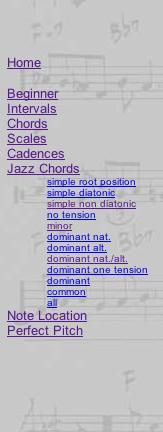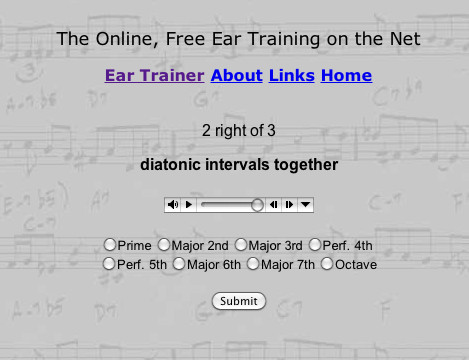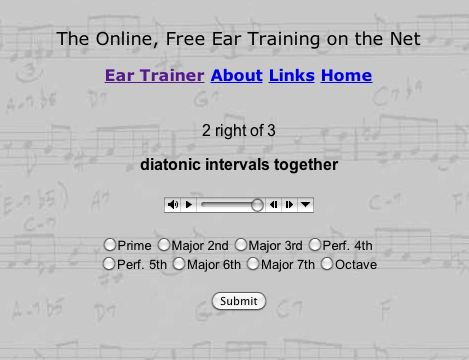This is the first in a series of posts looking at some of the valuable ear training resources across the web. We’re starting off with one of the “grand-daddies” of online aural skills training: Good-Ear.com.
If you’ve never seen this ear training app before, you might be underwhelmed by the simple design of good-ear.com. But don’t be fooled! There may be a lot more complicated tools out there for training your ear, but this site remains one of the most useful and efficient tools I’ve found yet. Read on for a more specific look at their app, then give it a try!
How to Use It
The whole design is like a multiple choice quiz: after selecting the focus of your ear training, an embedded QuickTime file will play you an interval or chord. You select the answer, and it keeps track of your score. On the right side of the page, you can adjust preferences, like the midi voice used in the intervals and the tempo.
 On the left is a table of contents containing—although they’re not clearly marked as such—drop down menus, through which you can select the training you want. In other words, you could choose ascending diatonic intervals, chords with inversions, modes of the melodic minor scale, etc. Navigating this list of links can be just slightly confusing at first, but you’ll catch on quickly as you go.
On the left is a table of contents containing—although they’re not clearly marked as such—drop down menus, through which you can select the training you want. In other words, you could choose ascending diatonic intervals, chords with inversions, modes of the melodic minor scale, etc. Navigating this list of links can be just slightly confusing at first, but you’ll catch on quickly as you go.

The slightly larger links each reveal several more links. All of these smaller links, when clicked, immediately cause the app to focus on that subject.
What You’ll Learn
Here’s where this app’s big advantage comes in: you can learn just about anything. The different methods of training are extremely well divided, so progressing from one to the other feels smooth and natural. If you’ve never sat down and focused on ear training before, it eases you in while keeping score—so there’s a built-in, fairly objective way of knowing when you’re ready to move on. If, on the other hand, you’re a pro in search of a new angle, you can start with dominant chords with tensions, harmonic minor modes, or even the perfect pitch feature and enjoy the same indications of progress.
Suggestions
There’s another great advantage to the point system that’s a little less functional: it turns it into a game. It’s one of those addictive Internet activities you might find yourself lost in for hours.
Every musician has, at one time or another, sacrificed practicing theory because of a headache. But what if it’s not a struggle? What if it’s just a link in your browser that you play a few rounds of every couple of hours? That’s how I like to use this app. You don’t have to sit down with the intent of having a huge practice session! Progress is easier to make with small steps.
Summary
No matter how much training you have as a musician, you can find plenty of value in this app. It’s easy, it’s fun, it’s effective… Why not try it out? And before you leave, make sure to check out their “links” section for some suggested sites about jazz theory and improvisation.








